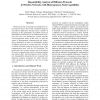Free Online Productivity Tools
i2Speak
i2Symbol
i2OCR
iTex2Img
iWeb2Print
iWeb2Shot
i2Type
iPdf2Split
iPdf2Merge
i2Bopomofo
i2Arabic
i2Style
i2Image
i2PDF
iLatex2Rtf
Sci2ools
EDCC
2010
Springer
2010
Springer
Dependability Analysis of Diffusion Protocols in Wireless Networks with Heterogeneous Node Capabilities
Wireless networks are starting to be populated by interconnected devices that reveal remarkable hardware and software differences. This fact raises a number of questions on the applicability of available results on dependability-related aspects of communication protocols, since they were obtained for wireless networks with homogeneous nodes. In this work, we study the impact of heterogeneous communication and computation capabilities of nodes on dependability aspects of diffusion protocols for wireless networks. We build a detailed stochastic model of the logic layers of the communication stack with the SAN formalism. The model takes into account relevant real-world aspects of wireless communication, such as transitional regions and capture effect, and heterogeneous node capabilities. Dependability-related metrics are evaluated with analytical solutions techniques for small networks, while simulation is employed in the case of large networks.
Applied Computing | Communication | EDCC 2010 | Heterogeneous Node Capabilities | Wireless Networks |
| Added | 19 Jul 2010 |
| Updated | 19 Jul 2010 |
| Type | Conference |
| Year | 2010 |
| Where | EDCC |
| Authors | Paolo Masci, Silvano Chiaradonna, Felicita Di Giandomenico |
Comments (0)

